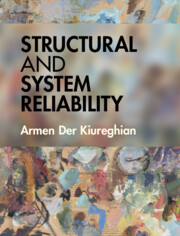Refine search
Actions for selected content:
2664 results in Civil and geotechnical engineering
9 - Kappa Distribution
-
- Book:
- Generalized Frequency Distributions for Environmental and Water Engineering
- Published online:
- 13 April 2022
- Print publication:
- 07 April 2022, pp 233-274
-
- Chapter
- Export citation
11 - Summary
-
- Book:
- Generalized Frequency Distributions for Environmental and Water Engineering
- Published online:
- 13 April 2022
- Print publication:
- 07 April 2022, pp 296-309
-
- Chapter
- Export citation
5 - Halphen Inverse B Distribution
-
- Book:
- Generalized Frequency Distributions for Environmental and Water Engineering
- Published online:
- 13 April 2022
- Print publication:
- 07 April 2022, pp 140-161
-
- Chapter
- Export citation
8 - Feller–Pareto Distribution
-
- Book:
- Generalized Frequency Distributions for Environmental and Water Engineering
- Published online:
- 13 April 2022
- Print publication:
- 07 April 2022, pp 208-232
-
- Chapter
- Export citation
2 - Burr–Singh–Maddala Distribution
-
- Book:
- Generalized Frequency Distributions for Environmental and Water Engineering
- Published online:
- 13 April 2022
- Print publication:
- 07 April 2022, pp 50-84
-
- Chapter
- Export citation
3 - Halphen Type A Distribution
-
- Book:
- Generalized Frequency Distributions for Environmental and Water Engineering
- Published online:
- 13 April 2022
- Print publication:
- 07 April 2022, pp 85-113
-
- Chapter
- Export citation
7 - Generalized Beta Lomax Distribution
-
- Book:
- Generalized Frequency Distributions for Environmental and Water Engineering
- Published online:
- 13 April 2022
- Print publication:
- 07 April 2022, pp 187-207
-
- Chapter
- Export citation
Dedication
-
- Book:
- Generalized Frequency Distributions for Environmental and Water Engineering
- Published online:
- 13 April 2022
- Print publication:
- 07 April 2022, pp v-vi
-
- Chapter
- Export citation
Copyright page
-
- Book:
- Generalized Frequency Distributions for Environmental and Water Engineering
- Published online:
- 13 April 2022
- Print publication:
- 07 April 2022, pp iv-iv
-
- Chapter
- Export citation
1 - Introduction
-
- Book:
- Generalized Frequency Distributions for Environmental and Water Engineering
- Published online:
- 13 April 2022
- Print publication:
- 07 April 2022, pp 1-49
-
- Chapter
- Export citation

Structural and System Reliability
-
- Published online:
- 13 January 2022
- Print publication:
- 13 January 2022
-
- Textbook
- Export citation
1 - Introduction
-
- Book:
- Structural and System Reliability
- Published online:
- 13 January 2022
- Print publication:
- 13 January 2022, pp 1-10
-
- Chapter
- Export citation
Acknowledgments
-
- Book:
- Structural and System Reliability
- Published online:
- 13 January 2022
- Print publication:
- 13 January 2022, pp xv-xvi
-
- Chapter
- Export citation
Preface
-
- Book:
- Structural and System Reliability
- Published online:
- 13 January 2022
- Print publication:
- 13 January 2022, pp xiii-xiv
-
- Chapter
- Export citation
4 - Formulation of Structural Reliability
-
- Book:
- Structural and System Reliability
- Published online:
- 13 January 2022
- Print publication:
- 13 January 2022, pp 93-107
-
- Chapter
- Export citation
15 - Bayesian Network for Reliability Assessment and Updating
-
- Book:
- Structural and System Reliability
- Published online:
- 13 January 2022
- Print publication:
- 13 January 2022, pp 523-571
-
- Chapter
- Export citation
5 - Analysis of Structural Reliability Under Incomplete Probability Information
-
- Book:
- Structural and System Reliability
- Published online:
- 13 January 2022
- Print publication:
- 13 January 2022, pp 108-134
-
- Chapter
- Export citation
7 - The Second-Order Reliability Method
-
- Book:
- Structural and System Reliability
- Published online:
- 13 January 2022
- Print publication:
- 13 January 2022, pp 185-199
-
- Chapter
- Export citation
11 - Time- and Space-Variant Reliability Analysis
-
- Book:
- Structural and System Reliability
- Published online:
- 13 January 2022
- Print publication:
- 13 January 2022, pp 357-404
-
- Chapter
- Export citation
9 - Simulation Methods
-
- Book:
- Structural and System Reliability
- Published online:
- 13 January 2022
- Print publication:
- 13 January 2022, pp 262-300
-
- Chapter
- Export citation
